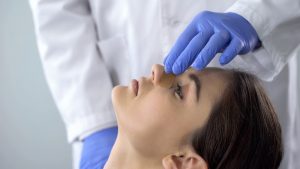Also Serving Facial Trauma Patients in Everett & Bellingham
At Cascade Facial Surgery, Dr. Jonathan Grant provides reconstructive surgery after pediatric or adult facial trauma. He evaluates scars, as well as bone and soft tissue injuries, and he strives to restore both function and appearance. He works closely with hospitals and has privileges at a number of community hospitals in the Western Washington area.
Dr. Grant treats every patient as a unique individual. Your surgical plan is designed specifically to provide you with the best possible result within the parameters of sound and safe medical practices. His training and experience as a reconstructive facial surgeon allows him to provide you with excellent cosmetic and functional restoration after an injury.
Who is a Candidate for Pediatric and Adult Facial Trauma Treatment?
Candidates for facial trauma reconstruction include those who have experienced the following injuries, just to name a few:
- A broken nose or other injury to the nose
- Deep cuts or incisions resulting in unsightly scars; these scars may be new or old
- Soft tissue injuries that have impaired function or appearance
- Fractures that have resulted in impaired function or appearance
Understanding the Facial Trauma Reconstruction Procedure
Dr. Grant will examine you during your consultation and discuss what he can do to improve function and aesthetics for you. Then, he can devise an optimal surgical plan.
The procedure required for facial trauma depends entirely on the injury and its severity. If your nose has been broken, the break in the bone needs to be reduced within a few days to weeks after injury. At a later date, rhinoplasty can be done to restore a more normal look to the nose if needed. If the injury has also resulted in impaired breathing, Dr. Grant can perform simultaneous nasal surgery for breathing problems along with your rhinoplasty.
In some cases, steroid injections may be all that are required, or they may be done in conjunction with surgery. For deep cuts or other soft tissue injuries, skin and soft tissue grafts may be necessary. If this is the case, Dr. Grant will advise you prior to your surgery of the area he intends to use for harvesting skin or soft tissue.
As a plastic surgeon trained in reconstruction techniques, Dr. Grant is skilled at minimizing scarring and improving the appearance of injury and post-surgical scars as much as possible. Part of the work he performs is improving the appearance of scars from prior surgeries.
Recovering From Facial Trauma Reconstruction
Recovery will depend upon your injury and its severity. We will provide you with full post-operative instructions, including how long you must take off from work and when you can exercise safely again.
After all surgeries, there is some pain, tightness, and swelling. Some patients also experience mild bruising and numbness. These symptoms are to be expected.
You can take pain medication to ease your discomfort as you heal. Sleeping upright or on your back with your head elevated for a couple of weeks will help to keep swelling to a minimum. We will give you instructions for showering, washing your hair, and using hair products/appliances.
Note that swelling and numbness are the last symptoms to resolve. It will take a few weeks and possibly months for you to see the final results of your surgery. Your scars will evolve and mature for a full year from the time of your surgery.
Facial Trauma FAQs
What is facial trauma?
 Facial trauma affects soft tissues, bones, or skin in the face. Fractures affecting the jaw, cheekbones, and nose are common examples. Lacerations and soft tissue injuries often occur as well.
Facial trauma affects soft tissues, bones, or skin in the face. Fractures affecting the jaw, cheekbones, and nose are common examples. Lacerations and soft tissue injuries often occur as well.
Some of the most common causes of facial trauma include accidents such as car collisions, sports injuries, falls, or physical assaults.
What are the signs of facial trauma?
In many cases, symptoms are obvious following a car accident, fall, or other types of trauma. Other times, the symptoms might be subtle.
Problems to look out for include:
- Pain: Pain may be dull or severe. It may affect the nose, jaw, eyes, or any other place within your face. Tooth pain is also possible.
- Swelling: Puffiness that may occur in just one area or across the whole face.
- Bruising: Blue, purple, or black discoloration around the nose or under the eyes.
- Sensitivity: Sensitivity is common after a traumatic injury. It might hurt to touch your nose or even be painful to breathe or close your eyes.
- Vision Issues: Depending on the area affected, you could experience vision issues, like blurry eyesight or difficulty seeing in darker conditions.
- Breathing Problems: When the bones and tissues of the nose are affected, it may be hard to breathe freely.
- Appearance Changes: Displaced bones and soft tissues may cause significant facial asymmetry.
How quickly should I seek treatment for a facial fracture?
Regarding facial fractures, watchful waiting isn’t wise. Any damage to facial structures could affect your quality of life or even put your life at risk.
One reason for this is that bones aren’t the only damaged part of your body after a facial impact, collision, or other trauma. Vital nerves and muscles surround the bones, so they’re often affected. In addition, any trauma to the maxilla (the bones of the upper jaw) can affect the brain.
The longer you wait, the higher the risk of irreversible damage. Proper facial joint, muscle, and nerve functions ensure you enjoy normal vision, breathing, speech, jaw movement, taste, and smell.
How is facial trauma diagnosed?
Dr. Grant performs a thorough physical exam, reviews your medical history, and may order imaging tests like X-rays or CT scans to assess your injury and design a treatment plan.
Can facial trauma lead to long-term complications?
If left untreated, facial trauma can result in complications such as chronic pain, difficulty breathing, impaired vision, or permanent changes in appearance. Timely treatment from an experienced specialist like Dr. Grant can help minimize these risks.
What are the treatment options for facial trauma?
 For less-severe injuries, options may include non-surgical care, like injections to reduce swelling and pain or stitches and splints for minor injuries. For more serious injuries, reconstructive facial surgery is often the best route to restore function and appearance. With this surgery, Dr. Grant repairs fractures and reconstructs soft tissues.
For less-severe injuries, options may include non-surgical care, like injections to reduce swelling and pain or stitches and splints for minor injuries. For more serious injuries, reconstructive facial surgery is often the best route to restore function and appearance. With this surgery, Dr. Grant repairs fractures and reconstructs soft tissues.
As the Seattle area’s foremost plastic and reconstructive surgeon, Dr. Grant is highly skilled in repairing damage and restoring appearance. He uses advanced techniques to minimize scarring and even reduce scars from previous injuries. Over time, scars can be treated with laser therapy, microneedling, or other treatments to improve their appearance.
What is the recovery time for facial trauma treatment?
Recovery times vary with injury severity, location, and type. Minor injuries may heal in only a few weeks, while more complex surgery cases can take several months.
Are facial implants used in facial trauma reconstruction?
Facial implants may sometimes be used to restore structural support or symmetry, especially if bone loss or significant deformities are present.
What specialists are involved in treating facial trauma?
Treating facial trauma often requires a team approach. Specialists may include oral and maxillofacial surgeons, plastic and reconstructive surgeons like Dr. Grant, ophthalmologists, and ENT doctors, depending on the type and severity of the injury.
Does insurance cover facial trauma repair?
Facial trauma repair is typically considered a medical necessity and may be covered by insurance. Our office can help you coordinate with your insurance provider to confirm coverage.
Can facial trauma be treated in children?
Yes, children can be treated for facial trauma. Dr. Grant takes extra care to account for a child’s growth and development, ensuring that repairs restore function and appearance yet don’t interfere with natural growth processes.
How do I prepare for surgery to repair facial trauma?
Preparation may include stopping certain medications, arranging for someone to drive you home, and following pre-surgery guidelines provided by Dr. Grant to ensure a safe and successful procedure.
Will I regain full function after facial trauma treatment?
Most patients recover full function with proper treatment, though outcomes depend on the severity of the injury. Dr. Grant tailors treatment plans to optimize both function and appearance.
How do I choose the right surgeon for facial trauma reconstruction?
Look for a surgeon with specialized training and experience, like Dr. Grant, who deeply understands facial anatomy and has a proven track record in trauma reconstruction. Choosing the right surgeon ensures your care is in expert hands.
If you need help with facial injuries, reach out to Dr. Jonathan Grant in Mt Vernon. As a top-rated plastic and reconstructive surgeon, he’s ready to restore your appearance and quality of life.
Learn More
If you need reconstruction after a facial trauma from a plastic surgeon in the Western Washington area, contact us for a consultation and examination with Dr. Grant.
Contact Us Today!






